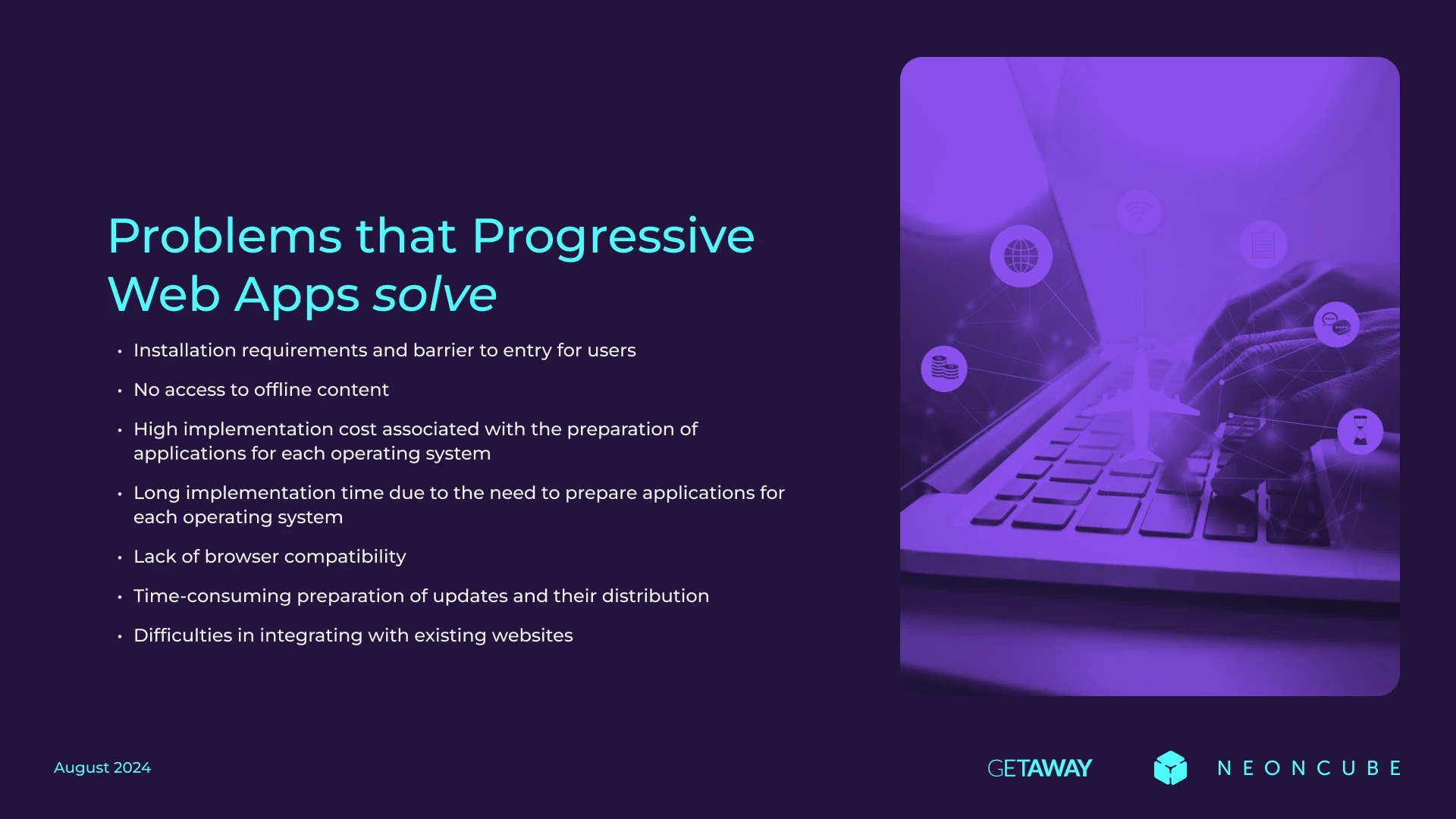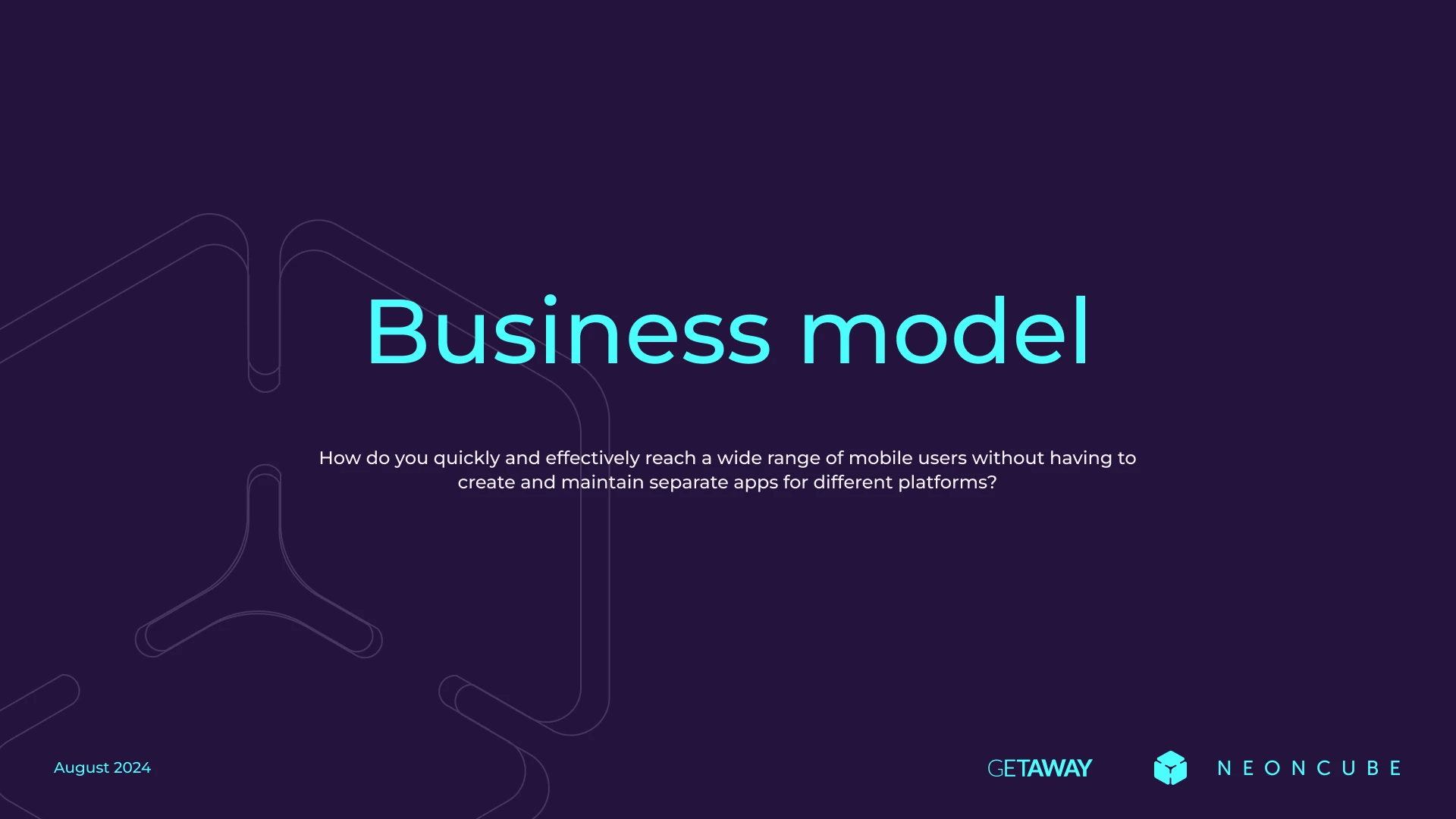One second. That's all it takes for a user to decide to leave the app and abandon further exploration. One of the biggest challenges is adapting the product to changing user expectations, requirements and behaviour. A key element to pay attention to is optimising the mobile experience. This raises the question - which solution to choose - Progressive Web Apps (PWA) versus Native Apps. How do these solutions affect business development, accessibility and cost?
Progressive Web App (PWA) - speed and versatility
Progressive Web App (PWA) are web applications that combine the best features of websites and native applications. The user gains a fast, accessible offline experience - as intuitive as native apps. The apps install on the device directly from the browser. In addition, they are easy to update, making them an attractive alternative to traditional mobile apps.
Progressive Web App is a solution for those looking for rapid deployment and broad reach across platforms without the additional costs of developing dedicated solutions for iOS and Android.

Advantages of Progressive Web Apps
Offline Access and Improved Performance – PWAs can be used offline thanks to service workers that cache the application locally. This not only enhances the user experience by allowing access without an internet connection but also improves the performance of the app on slow networks.
No Installation Required – unlike traditional apps, PWAs don't require users to download them from app stores. Users can access these apps directly via a web browser, which simplifies the process and removes the barrier of installation.
Cost-Effective – developing a PWA is generally cheaper and faster than creating native apps for multiple platforms since it involves using a single codebase across all platforms.
App-Like Experience – PWAs offer a user experience that closely mimics native apps with capabilities like push notifications, access to device hardware like cameras, and background syncing.
SEO Benefits – since PWAs are part of the web, they are discoverable by search engines, which can significantly help with search engine optimization (SEO) and improve the visibility of the app (Moqod | Software development).
Disadvantages of Progressive Web Apps
Limited Device Capabilities – PWAs have restricted access to certain mobile device features and sensors such as advanced camera controls, biometrics, NFC, or geofencing, which may be critical for certain types of apps.
High Battery Usage – despite their advantages, PWAs can consume more battery compared to native apps because they run high-level code that needs more resources to be interpreted by the device.
Dependence on Browser Compatibility – the performance and features of PWAs can vary significantly across different web browsers. Older or less popular browsers might not fully support all features of PWAs, which can affect user experience and functionality.
No App Store Presence – being web-based, PWAs miss out on the discoverability that comes with being listed in app stores. This can limit exposure to potential users who rely on app stores to find new apps.
Native Apps – performance and availability
Native Apps are software developed specifically for a particular operating system, which means they use its dedicated tools and features. Because they are written and compiled for a specific system, such as iOS or Android, they can directly and efficiently use the device's resources, such as GPS, camera, accelerometer or contact list.
Advantages of Native Apps
Performance – Native Apps are known for their high performance and smoothness because they are optimized for a specific hardware and operating system.
Access to device features – They can directly take advantage of features offered by devices, such as push notifications, touch gestures, and sensors, providing a richer user experience.
App store – are distributed through app stores (such as Google Play for Android and the App Store for iOS), which not only makes them easier for users to find, but also provides a security verification process before publication.
Disadvantages of Native Apps
Cost and production time – Native App development can be more expensive and time-consuming, as it requires creating separate versions for each operating system.
Maintenance – each app update requires resubmission to the app store and download by users, which can be a more complicated and slower process.
Native apps are ideal when superior user interaction, use of specific hardware features and superior performance are expected.
Business Impact
For businesses, choosing between a PWA and a native app often depends on the specific needs and goals of the application. PWAs can be particularly beneficial for organizations looking to reach a wide audience without the heavy investment required for native app development. They are ideal for projects where fast deployment and cross-platform accessibility are crucial. However, for applications that require deep integration with the device's hardware or where performance is critical, native apps might be the better option.
PWAs present a modern solution that bridges the gap between web pages and mobile apps, they come with limitations that may not make them suitable for every type of application. Deciding whether to use a PWA should consider both the technical capabilities required by the app and the strategic goals of the business.
When is it worth introducing a Progressive Web App?
Progressive Web App offers solutions for companies facing challenges such as:
- Limited budgets - PWA is an attractive alternative to native mobile applications, offering lower upfront and maintenance costs.
- Rapid implementation - with PWAs, a solution can be created in a short period of time that mimics the user experience of native applications, which is crucial in a rapidly changing market environment.
- Offline support - PWA applications can run without internet access.
- Experience similar to native apps - users can enjoy a full-screen view and interface that resembles native apps.
- Very easy installation - PWA does not require downloading via the app shop, which simplifies the installation process for the user.
- No need for regular updates by app shops - PWA updates are carried out automatically, reducing the burden on users.
- Availability of resources - an extensive base of frameworks and tools for PWAs makes application development easier and faster.
- Team - instead of hiring native application specialists, the skills of the existing frontend team can be used to create an attractive and functional user interface.

Case study: Getaway 2.0
Getaway 2.0 is a project that successfully used PWA to modernise and improve the mobile experience for users. The aim of the project was to provide users with an app that was both functional and intuitive, without the need to constantly redesign and create dedicated native apps for different platforms. The implementation included redesigning the responsive interface of the website, adding new components and implementing a PWA application.
Problem
The original version of the Getaway website suffered from a lack of a dedicated mobile app, and the available responsive version of the site was far from optimal. This caused loading issues, poor interaction and limited functionality.
Solution
To address these challenges, we implemented a PWA to enable faster loading of content, better offline accessibility and a responsive user interface. The project involved redesigning the entire user interface to better fit the needs and expectations of mobile users, as well as adding new features that were previously only available in native apps.
Implementation process
Analysis and planning The team started with a detailed analysis of user needs and the limitations of the previous version of the responsive website.
UX/UI redesign The focus was on creating a more intuitive and user-friendly interface that would be optimal for mobile devices.
Technical implementation Implementing 'service workers' to handle offline scenarios and an 'app shell model' that ensured fast loading and dynamic content loading.
Testing and optimisation Conduct a series of tests to ensure the stability and performance of the application on different devices and under different network conditions.
Development and iteration After the initial implementation, the team continued to work on additional improvements and functionalities.
Target achieved
Version 2.0 offered users a much better experience, similar to a native app. The introduction of PWA allowed Getaway to offer a native quality mobile experience while waiting for the development of full native solutions.
By using PWAs, the company has reduced the costs associated with creating and maintaining separate native applications for different platforms.
KPIs
We noted the success of the PWA implementation by monitoring the adoption of this technology.
Increase in the number of mobile users An increase of 40% in users using the mobile version of the app, indicating a high level of interest and satisfaction with the solution.
For whom will the PWA be a good solution?
Progressive Web Apps are an excellent start for companies that want to enter the mobile market quickly and efficiently without investing heavily in native solutions. PWAs allow you to achieve good results and find the right balance between functionality, cost and user satisfaction.
The Getaway 2.0 project shows how a strategic approach to mobile technology can make a significant difference to a company's growth and its ability to adapt to changing user expectations. Want to put Progressive Web Apps into practice? Download our Pitch-Deck!